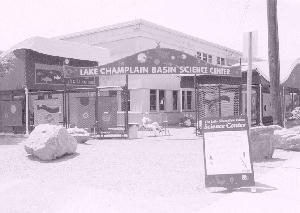Science Center Obtains $900K Grant
New 40,000 sq.ft building project planned
By Chris Costigan
By the summer of the prophetic year of 2001, Burlington residents and outside patrons will be visiting a revamped Lake Champlain Basin Science Center.
With a prospective construction date to begin some time in the year 2000, the already existing 10,000-sq. ft. complex will be replaced with a 40,000-sq. ft. improvement. A handful of key players have made this opportunity come to life for the center. Sen. Patrick Leahy and his staff have been instrumental in obtaining a $900,000 grant from the Federal Housing and Urban Development Administration (HUD).
“This grant recognizes our contribution to the urban development of the Lake Champlain region,” says Sarah Muyskens, co-director of the center.
This $900,000 grant is the offspring of a $2 million dollar grant from local businessmen and regional benefactors J. Warren and Lois McClure. In October the McClures donated this sum to the science center and the Maritime Museum in Vergennes (who will be establishing a Burlington presence with a major exhibit). Two other local businesses (who wish to remain anonymous) have each donated $50,000 to the cause. This $1 million and a donation from the State of Vermont of $30,000 is being used to match the McClure gift. Two reasons exist for the building of a new science center. One deals with the sign of the times.
Muyskens says, “Programmatically what we want to bring to the community doesn’t fit in the existing building.”
Presently, the low ceilings and small rooms stand in the way of the science centers full potential.
“We’re giving people a taste of the future when they come to our home today.” Muyskens says.
The second reason involves the ever-looming presence of money. Apparently it would be extremely expensive to bring this building to code. The science center was built about fifty years ago and although it meets the building code standards right now, this would be subject to change when a change in the use of the building occurred. These standards include fire safety, handicap accessibility and energy efficiency.
The new and improved building will house more exhibits and make programs more plentiful and accessible. A major benefit that will sit nicely with the science center is the completion of phase one of the project—University of Vermont’s (UVM) $3.5 million Rubenstein laboratory. This new addition to the lake side education family will sit right next door to the science center. This public accessible, state of the art research lab is scheduled to open in the summer of 1999. The facility will focus upon the health of the ecosystem of Lake Champlain. The lab will feature an opportunity for the public to observe Lake Champlain Basin scientists at work. Teaching labs will also be made available to both high school and collegiate level students. Grade school kids will use the science center by assuming the roles of Eco-detectives.
“Children of the third grade and up will be the eyes and ears of the basin,” Muyskens explains. “We’ve purchased things like water testing kits with money from grants.” Kids younger than the third grade are given the chance to discover and participate in programs designed to provide fun while learning about the water and the lake. “There are very few labs in the nation that are adjacent to a public educational facility,” Muyskens concludes. “We could become a national model.”



